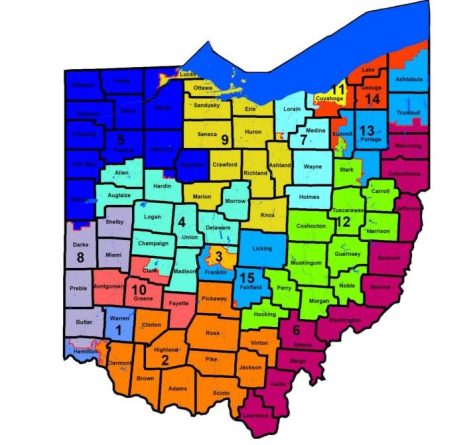Ohio district maps are still an uphill battle
March 6, 2022
After the 2020 census determined Ohio would lose one House representative, the state set out to draw a new map of electoral districts, a task that has created conflict between the state Supreme Court and the commission charged with creating the maps.
There are three maps in question right now, said political reporter for The Plain Dealer Thomas Suddes. The first, and most well known, is the map for Ohio’s federal House of Representatives.
In the House, each state is given representation proportional to its population. Because Ohio’s population grew slower between the 2010 and 2020 censuses than many other states, the state’s number of House representatives dropped from 16 to 15.
That’s not the only map that needs to be redrawn, though. Both houses of Ohio’s state legislature are required to revise their maps every 10 years. While the commission that creates these maps uses the new census results as a guide, the number of seats in each chamber is always the same–33 in the Senate, and 99 in the House.
“The map the (Ohio) Supreme Court has the most problems with right now is the (state) House map,” Suddes said. “They have strict rules to follow; they can’t cut off communities like towns or villages more than once, and they have to be as proportionate to population as possible.”

Twice now, Ohio’s Supreme Court rejected maps passed by the redistricting commission, deeming them unconstitutional.
The rejected maps did not split the legislature in a way that accurately reflects Ohio’s voting records, said Kenneth Bindas, a history professor at Kent State.
In the court’s opinion on the case, Democratic Justice Michael Donnelly wrote that, in the federal House districts, the state should expect 53 percent of seats to go to Republicans. In the map passed by the commission, the number was closer to 80 percent.
The court gave the commission until Feb. 17 to draw a third map with more properly distributed districts. The commission did not meet the deadline, with Ohio Senate President Matt Huffman claiming the task was “impossible.” What happens next is up in the air, Suddes said.
“You could order the commission to try one more time, which the commission is not required to do, as far as I know,” Suddes said. “The second thing is that (the Ohio Supreme Court) could hold members of the commission in contempt.”
This conflict could lead to an even more complex crisis regarding the separation of powers within the state. The highest-ranking members of both legislative chambers are members of the commission, as well as Gov. Mike DeWine. To hold any of these people in contempt of court could lead to a deeper crisis.

The third option would be for the Ohio Supreme Court to have experts draw a map for the commission to approve. While DeWine said on Feb. 17 that such a proposal from the court would be his preference, it is unclear if the commission would approve it.
With the primary election on May 4, it is becoming increasingly necessary for a map to be approved as quickly as possible.
This level of conflict in the redistricting process is new to this cycle, said Bindas. While the state has created partisan state legislative district maps since 1967, following the creation of a five-member redistricting commission, the district map adopted in 2011 was particularly unpopular within the state.
The partisan nature of Ohio’s Supreme Court is the primary reason this crisis has blindsided many Republicans, Bindas said. In Ohio’s Supreme Court, unlike the federal Supreme Court, the position of justice is an elected one, where potential justices run attached to a party. The current makeup of the court is four Republicans to three Democrats.
“The commission assumed that the Court would fall along party lines,” Bindas said. “Chief Justice O’Connor surprised them by ruling the maps unconstitutional. She’s already taking a lot of heat from Republicans for these decisions.”
Lynn Vandrasik is a reporter. Contact her at [email protected].
























